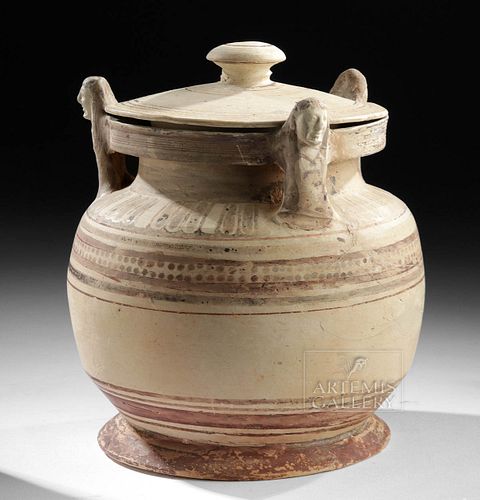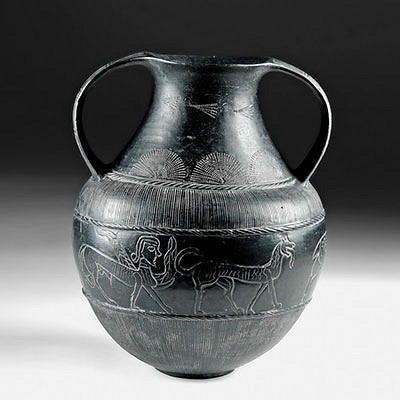Greek Corinthian Lidded Pyxis Caryatids, ex-Sotheby's
Lot 15
About Seller
Artemis Fine Arts
686 S Taylor Ave, Ste 106
Louisville, CO 80027
United States
Selling antiquities, ancient and ethnographic art online since 1993, Artemis Gallery specializes in Classical Antiquities (Egyptian, Greek, Roman, Near Eastern), Asian, Pre-Columbian, African / Tribal / Oceanographic art. Our extensive inventory includes pottery, stone, metal, wood, glass and textil...Read more
Categories
Estimate:
$3,000 - $4,000
Absentee vs Live bid
Two ways to bid:
- Leave a max absentee bid and the platform will bid on your behalf up to your maximum bid during the live auction.
- Bid live during the auction and your bids will be submitted real-time to the auctioneer.
Bid Increments
| Price | Bid Increment |
|---|---|
| $0 | $25 |
| $300 | $50 |
| $1,000 | $100 |
| $2,000 | $250 |
| $5,000 | $500 |
| $10,000 | $1,000 |
| $20,000 | $2,500 |
| $50,000 | $5,000 |
| $100,000 | $10,000 |
| $200,000 | $20,000 |
About Auction
By Artemis Fine Arts
Sep 17, 2020
Set Reminder
2020-09-17 10:00:00
2020-09-17 10:00:00
America/New_York
Bidsquare
Bidsquare : CLEARANCE - Ancient, Pre-Columbian, Ethno Art
https://www.bidsquare.com/auctions/artemis-gallery/clearance---ancient-pre-columbian-ethno-art-5605
End-of-Summer Clearance sale featuring discounted pricing on antiquities from Egypt, Greece, Italy, and the Near East...plus Viking, Asian, Pre-Columbian, Tribal, Russian Icons, Spanish Colonial, Fine Art, more! Starting prices have been reduced up to 65% from original auction prices. Artemis Fine Arts info@artemisgallery.com
End-of-Summer Clearance sale featuring discounted pricing on antiquities from Egypt, Greece, Italy, and the Near East...plus Viking, Asian, Pre-Columbian, Tribal, Russian Icons, Spanish Colonial, Fine Art, more! Starting prices have been reduced up to 65% from original auction prices. Artemis Fine Arts info@artemisgallery.com
- Lot Description
**Originally Listed At $2500**
Greece, Corinth, ca. late 6th century BCE. A lidded polychrome pyxis, most likely used to hold cosmetics, ointments, or trinkets - its attractive form comprised of a globular body, corseted shoulder, short neck that flares to an everted rim with three caryatids joining rim to shoulder, all on a flared, concave foot with a knobbed, fitted lid. The surface presents an attractive decorative program with bands of striations and dotted/beaded bands on the body and tongues on the shoulder. What's more, the caryatid supports make this piece extra special. A stunning vessel boasting a lovely silhouette and finely painted as well as modeled decoration. Size: 4.875" in diameter x 5.5" H (12.4 cm x 14 cm)
The caryatid which originated in ancient Greece was a sculpted female figure that functioned as an architectural support, replacing a standard column or pillar and actually supporting a temple's entablature. The most famous caryatids were created for the south porch of the Erechtheion gracing the Acropolis of Athens. The lovely caryatids embellishing this pyxis depict finely modeled and painted busts presenting beautiful visages with naturalistic, feminine features and long coiffures above elegant torsos with painted necklaces and garments.
Provenance: private East Coast, USA collection; ex-private New York, USA collection, acquired at Sotheby's, New York (June, 2000, lot 227)
All items legal to buy/sell under U.S. Statute covering cultural patrimony Code 2600, CHAPTER 14, and are guaranteed to be as described or your money back.
A Certificate of Authenticity will accompany all winning bids.
We ship worldwide and handle all shipping in-house for your convenience.
#146891Lid repaired from three pieces. Areas of repair/restoration to vessel walls. Chips to rim of lid and rim of vessel. Small loss to head of one caryatid. Encrustation on underside of base. Indentation to side wall. Repair or stabilized cracks to shoulder/side wall. One caryatid reattached. Nicks to rim of lid, rim of lower vessel, and periphery of base. Expected surface wear with pigment loss and a few scuffs here and there. Still, overall a very rare and impressive piece.Condition
- Shipping Info
-
All shipping is handled in-house for your convenience. Your invoice from Artemis Gallery will include shipping calculation instructions. If in doubt, please inquire BEFORE bidding for estimated shipping costs for individual items.
-
- Buyer's Premium



 EUR
EUR CAD
CAD AUD
AUD GBP
GBP MXN
MXN HKD
HKD CNY
CNY MYR
MYR SEK
SEK SGD
SGD CHF
CHF THB
THB
















